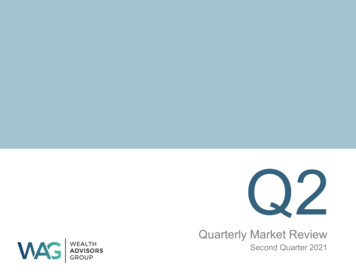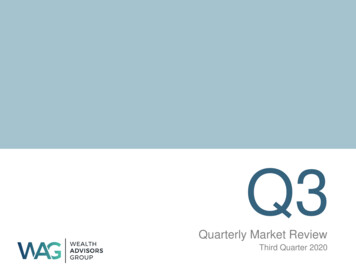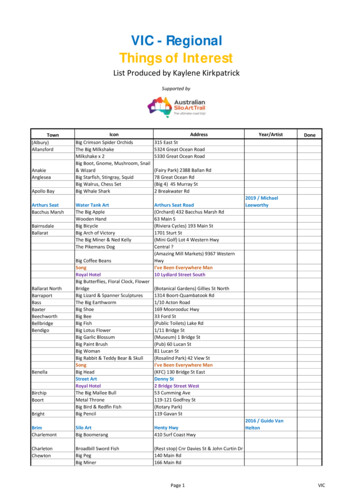
Transcription
Q4Quarterly Market ReviewFourth Quarter 2019
Quarterly Market ReviewFourth Quarter 2019This report features world capital marketperformance and a timeline of eventsfor the past quarter. It begins with aglobal overview, then features thereturns of stock and bond asset classesin the US and international markets.Overview:The report also illustrates the impact ofglobally diversified portfolios and featuresa quarterly topic.World Asset ClassesMarket SummaryWorld Stock Market PerformanceUS StocksInternational Developed StocksEmerging Markets StocksSelect Market PerformanceSelect Currency Performancevs. US DollarReal Estate Investment Trusts (REITs)CommoditiesFixed IncomeGlobal Fixed IncomeImpact of DiversificationQuarterly Topic: Tuning Out the Noise2
Quarterly Market SummaryIndex ReturnsUS StockMarket4Q cksGlobalRealEstateSTOCKSUS BondMarketGlobalBondMarketex %2.6%1.2%1.1%16.8%25.9%34.7%32.3%4.6%4.6%2009 Q22009 Q22009 Q22009 Q32001 Q32008 Q4-22.8%-21.1%-27.6%-36.1%-3.0%-2.7%2008 Q42008 Q42008 Q42008 Q42016 Q42015 Q2Since Jan. 2001Avg. QuarterlyReturnBestQuarterWorstQuarterPast performance is not a guarantee of future results. Indices are not available for direct investment. Index performance does not reflect the expenses associated withthe management of an actual portfolio. Market segment (index representation) as follows: US Stock Market (Russell 3000 Index), International Developed Stocks (MSCI Worldex USA Index [net div.]), Emerging Markets (MSCI Emerging Markets Index [net div.]), Global Real Estate (S&P Global REIT Index [net div.]), US Bond Market (BloombergBarclays US Aggregate Bond Index), and Global Bond Market ex US (Bloomberg Barclays Global Aggregate ex-USD Bond Index [hedged to USD]). S&P data 2020 S&P DowJones Indices LLC, a division of S&P Global. All rights reserved. Frank Russell Company is the source and owner of the trademarks, service marks, and copyrights related to theRussell Indexes. MSCI data MSCI 2020, all rights reserved. Bloomberg Barclays data provided by Bloomberg.3
Long-Term Market SummaryIndex ReturnsUS StockMarket1 cksGlobalRealEstateSTOCKSUS BondMarketGlobalBondMarketex 29%5 Years10 YearsPast performance is not a guarantee of future results. Indices are not available for direct investment. Index performance does not reflect the expenses associated withthe management of an actual portfolio. Market segment (index representation) as follows: US Stock Market (Russell 3000 Index), International Developed Stocks (MSCI Worldex USA Index [net div.]), Emerging Markets (MSCI Emerging Markets Index [net div.]), Global Real Estate (S&P Global REIT Index [net div.]), US Bond Market (BloombergBarclays US Aggregate Bond Index), and Global Bond Market ex US (Bloomberg Barclays Global Aggregate ex-USD Bond Index [hedged to USD]). S&P data 2020 S&P DowJones Indices LLC, a division of S&P Global. All rights reserved. Frank Russell Company is the source and owner of the trademarks, service marks, and copyrights related to theRussell Indexes. MSCI data MSCI 2020, all rights reserved. Bloomberg Barclays data provided by Bloomberg.4
World Stock Market PerformanceMSCI All Country World Index with selected headlines from Q4 2019290280270260250240230Sep 30Oct 31“ManufacturingSputters asBroader USEconomy Slows”“Fed Cuts Rate forThird Time ThisYear, SignalsPause”Nov 30“Gas PricesDrive OctoberInflationIncrease”“China’s ConsumerInflation Soars toHighest Level in Years”“OPEC, Allies ConsiderDeeper Output Cuts AmidSigns of Weaker Demand”“US Deficit HitsSeven-Year High”“US GrowthEnters FourthQuarter on MoreSolid Footing”Dec 31“Boris JohnsonSecures aResoundingUK ElectionWin”“Charles Schwab toBuy TD Ameritradefor 26 Billion”“Value Stocks AreBack in Vogue”“US UnemploymentRate Drops to 50Year Low of 3.5%”“US Stocks CloseOut Decade with190% Gain”“Fed Keeps InterestRates Steady,Sees Long Pause”“US, China Agree toLimited Deal toHalt Trade War”These headlines are not offered to explain market returns. Instead, they serve as a reminder that investors should view daily events from along-term perspective and avoid making investment decisions based solely on the news.Graph Source: MSCI ACWI Index [net div.]. MSCI data MSCI 2020, all rights reserved.It is not possible to invest directly in an index. Performance does not reflect the expenses associated with management of an actual portfolio. Past performance is not aguarantee of future results.5
World Stock Market PerformanceMSCI All Country World Index with selected headlines from past 12 monthsLONG TERM (2000–Q4 2019)300200SHORT TERM (Q1 2019–Q4 2019)Last 20210Jan 1Apr 1Jul 1Oct 1Dec 31“Boris Johnson“Home-Price“US Job Openings“ECB LaunchesSecures aGrowth SlowsOutnumberMajor StimulusResoundingto Lowest Level Unemployed by “China Growth atPackage, Cuts“ManufacturingUK ElectionSince 2012”Widest Gap Ever” Its Slowest since Key Rate”Sputters as1992 as BeijingWin”Broader USStruggles toEconomy Slows”Juice Economy”“US ConsumerSentiment Hits“China’s Consumer“Dow Sheds 800 inHighest Level inInflation Soars toBiggest Drop of Year”15 Years”Highest Level in Years”“S&P 500 Posts“May’s Brexit Deal IsBest First Half“US StocksRejected for a Thirdin 22 Years”Close Out“Fed Cuts Rates byTime by Lawmakers”Decade withQuarter Point but190% Gain”Faces Growing Split”“US IndexesClose with WorstYearly LossesSince 2008”“Oil Rises Sharply onOPEC ProductionCuts, Falling USStockpiles”These headlines are not offered to explain market returns. Instead, they serve as a reminder that investors should view daily events from along-term perspective and avoid making investment decisions based solely on the news.Graph Source: MSCI ACWI Index [net div.]. MSCI data MSCI 2020, all rights reserved.It is not possible to invest directly in an index. Performance does not reflect the expenses associated with management of an actual portfolio. Past performance is not aguarantee of future results.6
World Asset ClassesFourth Quarter 2019 Index Returns (%)Equity markets around the globe posted positive returns in the fourth quarter. Looking at broad marketindices, US equities outperformed non-US developed markets but underperformed emerging markets.Value stocks underperformed growth stocks in all regions. Small caps outperformed large caps in the USand non-US developed markets but underperformed in emerging markets.REIT indices underperformed equity market indices in both the US and non-US developed markets.MSCI Emerging Markets Index (net div.)11.84MSCI World ex USA Small Cap Index (net div.)11.40MSCI Emerging Markets Value Index (net div.)9.94Russell 2000 Index9.94MSCI Emerging Markets Small Cap Index (net div.)9.52Russell 3000 Index9.10S&P 500 Index9.07Russell 1000 Index9.04MSCI All Country World ex USA Index (net div.)8.92Russell 2000 Value Index8.49MSCI World ex USA Index (net div.)7.86MSCI World ex USA Value Index (net div.)7.56Russell 1000 Value Index7.41S&P Global ex US REIT Index (net div.)One-Month US Treasury BillsBloomberg Barclays US Aggregate Bond Index4.440.410.18Dow Jones US Select REIT Index -1.23Past performance is not a guarantee of future results. Indices are not available for direct investment. Index performance does not reflect the expenses associated withthe management of an actual portfolio. The S&P data is provided by Standard & Poor's Index Services Group. Frank Russell Company is the source and owner of thetrademarks, service marks, and copyrights related to the Russell Indexes. MSCI data MSCI 2020, all rights reserved. Dow Jones data 2020 S&P Dow Jones Indices LLC, adivision of S&P Global. All rights reserved. S&P data 2020 S&P Dow Jones Indices LLC, a division of S&P Global. All rights reserved. Bloomberg Barclays data provided byBloomberg. Treasury bills Stocks, Bonds, Bills, and Inflation Yearbook , Ibbotson Associates, Chicago (annually updated work by Roger G. Ibbotson and Rex A. Sinquefield).7
US StocksFourth Quarter 2019 Index ReturnsUS equities outperformed non-USdeveloped equities but underperformedemerging markets stocks in thefourth quarter.Ranked Returns (%)Small GrowthValue underperformed growth in the USacross large and small cap stocks.Small caps outperformed large caps inthe US.REIT indices underperformed equitymarket indices.11.39Large Growth10.62Small Cap9.94Marketwide9.10Large Cap9.04Small Value8.49Large ValueWorld Market Capitalization—US55%US Market 31.7 trillion7.41Period Returns (%)* AnnualizedAsset ClassQTR1 Year3 Years**5 Years**10 Years**Small Growth11.3928.48Large Growth10.6236.3912.499.3413.0120.4914.6315.22Small 1.2413.42Large Cap9.0431.43Small Value8.4922.3915.0511.4813.544.776.9910.56Large Value7.4126.549.688.2911.80Past performance is not a guarantee of future results. Indices are not available for direct investment. Index performance does not reflect the expenses associated with themanagement of an actual portfolio. Market segment (index representation) as follows: Marketwide (Russell 3000 Index), Large Cap (Russell 1000 Index), Large Cap Value (Russell1000 Value Index), Large Cap Growth (Russell 1000 Growth Index), Small Cap (Russell 2000 Index), Small Cap Value (Russell 2000 Value Index), and Small Cap Growth (Russell 2000Growth Index). World Market Cap represented by Russell 3000 Index, MSCI World ex USA IMI Index, and MSCI Emerging Markets IMI Index. Russell 3000 Index is used as the proxyfor the US market. Dow Jones US Select REIT Index used as proxy for the US REIT market. Frank Russell Company is source and owner of trademarks, service marks, and copyrightsrelated to Russell Indexes. MSCI data MSCI 2020, all rights reserved.8
International Developed StocksFourth Quarter 2019 Index ReturnsIn US dollar terms, developed marketsoutside the US underperformed both theUS equity market and emerging marketsequities during the quarter.Small caps outperformed large caps innon-US developed markets.Value underperformed growth acrosslarge and small cap stocks.Ranked Returns (%)Local currencySmallCapUS 6Value7.56World Market Capitalization—International DevelopedPeriod Returns (%)Asset ClassQTR1 86.51Large Small Cap33%InternationalDeveloped Market 19.2 trillion* Annualized3 Years** 5 Years** 10 Years**Past performance is not a guarantee of future results. Indices are not available for direct investment. Index performance does not reflect the expenses associated withthe management of an actual portfolio. Market segment (index representation) as follows: Large Cap (MSCI World ex USA Index), Small Cap (MSCI World ex USA Small CapIndex), Value (MSCI World ex USA Value Index), and Growth (MSCI World ex USA Growth Index). All index returns are net of withholding tax on dividends. World Market Caprepresented by Russell 3000 Index, MSCI World ex USA IMI Index, and MSCI Emerging Markets IMI Index. MSCI World ex USA IMI Index is used as the proxy for theInternational Developed market. MSCI data MSCI 2020, all rights reserved. Frank Russell Company is the source and owner of the trademarks, service marks, and copyrightsrelated to the Russell Indexes.9
Emerging Markets StocksFourth Quarter 2019 Index ReturnsIn US dollar terms, emerging marketsoutperformed developed markets,including the US, in the fourth quarter.Ranked Returns (%)Local currencyValue stocks underperformedgrowth stocks.US currency11.46Growth13.68Small caps underperformed large caps.9.54Large Cap11.847.58Value9.946.94Small Cap9.52World Market Capitalization—Emerging MarketsPeriod Returns (%)Asset Class12%* AnnualizedQTR1 YearGrowth13.6825.1014.507.455.20Large 08Small Cap9.5211.506.702.972.953 Years** 5 Years** 10 Years**EmergingMarkets 6.9 trillionPast performance is not a guarantee of future results. Indices are not available for direct investment. Index performance does not reflect the expenses associated withthe management of an actual portfolio. Market segment (index representation) as follows: Large Cap (MSCI Emerging Markets Index), Small Cap (MSCI Emerging MarketsSmall Cap Index), Value (MSCI Emerging Markets Value Index), and Growth (MSCI Emerging Markets Growth Index). All index returns are net of withholding tax on dividends.World Market Cap represented by Russell 3000 Index, MSCI World ex USA IMI Index, and MSCI Emerging Markets IMI Index. MSCI Emerging Markets IMI Index used as theproxy for the emerging market portion of the market. MSCI data MSCI 2020, all rights reserved. Frank Russell Company is the source and owner of the trademarks, servicemarks, and copyrights related to the Russell Indexes.10
Select Market PerformanceFourth Quarter 2019 Index ReturnsIn US dollar terms, Ireland and Sweden recorded the highest country performance in developed marketsduring the fourth quarter, while Australia and Belgium posted the lowest returns. In emerging markets,Pakistan and Hungary were the top performers, while Chile and Thailand posted the lowest performance.Ranked Developed Markets Returns (%)Ranked Emerging Markets Returns (%)Ireland16.48Sweden14.19Denmark13.21New .019.11ColombiaUS8.92South 27.3613.9113.16Greece11.68Czech srael7.28Saudi ArabiaHong y1.41UAE-1.11Thailand-1.25Chile -10.07Past performance is not a guarantee of future results. Indices are not available for direct investment. Index performance does not reflect the expenses associatedwith the management of an actual portfolio. Country performance based on respective indices in the MSCI World ex US IMI Index (for developed markets), MSCI USA IMI Index(for US), and MSCI Emerging Markets IMI Index. All returns in USD and net of withholding tax on dividends. MSCI data MSCI 2020, all rights reserved. UAE and Qatar havebeen reclassified as emerging markets by MSCI, effective May 2014. Saudi Arabia and Argentina have been reclassified as emerging markets by MSCI, effective May 2019.11
Select Currency Performance vs. US DollarFourth Quarter 2019In developed and emerging markets, most currencies appreciated vs. the US dollar. The few exceptionsincluded the Japanese yen and the Turkish lira.Ranked Developed Markets Returns (%)Ranked Emerging Markets Returns (%)New Zealand dollar (NZD)7.59British pound (GBP)7.50Swedish krona (SEK)5.03Australian dollar (AUD)4.23Norwegian krone (NOK)3.40Swiss franc (CHF)2.97Euro (EUR)2.96Danish krone (DKK)2.88Singapore dollar (SGD)2.84Canadian dollar (CAD)2.10South African rand (ZAR)8.43Colombian peso (COP)6.00Polish zloty (PLN)5.86Czech koruna (CZK)4.59Mexican peso (MXN)4.55Russian ruble (RUB)4.46Hungarian forint (HUF)4.29Brazilian real (BRL)3.55New Taiwan dollar (TWD)3.49Korean won (KRW)3.43Chinese renminbi (CNY)2.48Malaysian ringgit (MYR)2.36Philippine peso (PHP)2.34Indonesian rupiah (IDR)2.25Peruvian sol (PEN)2.20Thai baht (THB)2.11Egyptian pound (EGP)1.35Pakistani rupee (PKR)Israeli new shekel (ILS)0.630.94Saudi Arabian riyal (SAR)-0.00Indian rupee (INR)Hong Kong dollar (HKD)0.61Chilean peso (CLP)Argentinian peso (ARS)Japanese yen (JPY)-0.55-0.71-3.16-3.80Turkish lira (TRY) -5.12Past performance is not a guarantee of future results. Indices are not available for direct investment. Index performance does not reflect the expenses associated withthe management of an actual portfolio.MSCI data MSCI 2020, all rights reserved.12
Real Estate Investment Trusts (REITs)Fourth Quarter 2019 Index ReturnsUS real estate investment trusts (REITs)underperformed non-US REITs in USdollar terms during the fourth quarter.Ranked Returns (%)US REITS-1.23Global ex US REITSTotal Value of REIT StocksPeriod Returns (%)43%World ex US 540 billion254 REITs(22 othercountries)4.44* AnnualizedAsset ClassQTRGlobal ex US S REITS1 Year 3 Years** 5 Years** 10 Years**57%US 718 billion94 REITsPast performance is not a guarantee of future results. Indices are not available for direct investment. Index performance does not reflect the expenses associated withthe management of an actual portfolio. Number of REIT stocks and total value based on the two indices. All index returns are net of withholding tax on dividends. Total value ofREIT stocks represented by Dow Jones US Select REIT Index and the S&P Global ex US REIT Index. Dow Jones US Select REIT Index used as proxy for the US market, andS&P Global ex US REIT Index used as proxy for the World ex US market. Dow Jones and S&P data 2020 S&P Dow Jones Indices LLC, a division of S&P Global. All rightsreserved.13
CommoditiesFourth Quarter 2019 Index ReturnsThe Bloomberg Commodity IndexTotal Return increased 4.42% inthe fourth quarter.Coffee and soybean oil were the topperformers, gaining 24.33% and17.62%, respectively.Nickel and natural gas were the worstperformers, declining by 17.97% and17.57%, respectively.Ranked Returns (%)Coffee24.33Soybean oil17.62Brent crude oil15.72Kansas wheat14.94WTI crude oil13.39Unleaded gas12.92Wheat11.70Cotton10.46Live cattle8.83Heating oil8.76Copper8.06Low sulphur gas eans2.21Soybean meal-0.83Corn-2.35ZincLean hogs-4.48-15.30Natural gas -17.57Nickel -17.97Period Returns (%)Asset ClassQTRCommodities4.42* Annualized1 Year 3 Years** 5 Years** 10 Years**7.69-0.94-3.92-4.73Past performance is not a guarantee of future results. Index is not available for direct investment. Index performance does not reflect the expenses associated with themanagement of an actual portfolio. Commodities returns represent the return of the Bloomberg Commodity Total Return Index. Individual commodities are sub-index values ofthe Bloomberg Commodity Total Return Index. Data provided by Bloomberg.14
Fixed IncomeFourth Quarter 2019 Index ReturnsInterest rate changes were mixed in the USTreasury market during the fourth quarter.The yield on the 5-year Treasury noteincreased 14 basis points (bps), ending at1.69%. The yield on the 10-year note rose24 bps to 1.92%. The 30-year Treasurybond yield increased 27 bps to 2.39%.US Treasury Yield Curve (%)4.00On the short end of the yield curve, the 1month Treasury bill yield decreased to1.48%, while the yield on the 1-year billdipped 16 bps to 1.59%. The 2-year noteyield finished at 1.58% after a decrease of5 bps.In terms of total returns, short-termcorporate bonds gained 0.95%.Intermediate corporate bonds had a totalreturn of 01Yr5Yr10Yr30YrBond Yields across Issuers (%)The total return for short-term municipalbonds was 0.84%, while intermediate-termmunis returned 0.93%. General obligationbonds outperformed revenue bonds.2.731.9210-Year USTreasuryState and LocalMunicipals2.992.44AAA-AACorporatesPeriod Returns (%)A-BBBCorporates*AnnualizedAsset ClassQTR1 Year3 Years**5 Years**Bloomberg Barclays US High Yield Corporate Bond Index2.6114.326.376.137.57FTSE World Government Bond Index 1-5 Years1.012.432.400.740.19Bloomberg Barclays US TIPS Index0.798.433.322.623.36Bloomberg Barclays Municipal Bond Index0.747.544.723.534.34ICE BofA 1-Year US Treasury Note Index0.592.931.781.250.83ICE BofA US 3-Month Treasury Bill Index0.462.281.671.070.58Bloomberg Barclays US Aggregate Bond Index0.188.724.033.053.75FTSE World Government Bond Index 1-5 Years (hedged to mberg Barclays US Government Bond Index Long10 Years**One basis point (bps) equals 0.01%. Past performance is not a guarantee of future results. Indices are not available for direct investment. Index performance does notreflect the expenses associated with the management of an actual portfolio. Yield curve data from Federal Reserve. State and local bonds are from the S&P National AMTFree Municipal Bond Index. AAA-AA Corporates represent the ICE BofA US Corporates, AA-AAA rated. A-BBB Corporates represent the ICE BofA US Corporates, BBB-A rated.Bloomberg Barclays data provided by Bloomberg. US long-term bonds, bills, inflation, and fixed income factor data Stocks, Bonds, Bills, and Inflation (SBBI) Yearbook ,Ibbotson Associates, Chicago (annually updated work by Roger G. Ibbotson and Rex A. Sinquefield). FTSE fixed income indices 2020 FTSE Fixed Income LLC, all rightsreserved. ICE BofA index data 2020 ICE Data Indices, LLC. S&P data 2020 S&P Dow Jones Indices LLC, a division of S&P Global. All rights reserved.15
Global Fixed IncomeFourth Quarter 2019 Yield CurvesInterest rates in global developed markets generallyincreased during the fourth quarter.Longer-term bonds generally underperformedshorter-term bonds in the global developed markets.Short- and intermediate-term nominal rates arenegative in Japan and Germany.USChanges in Yields (bps) since 2.01.00.0Yield (%)Yield 0Y30Y1Y5YYears to 0/20190.0Yield (%)Yield (%)20YYears to 5Y10Y20Y30Y1Y5YYears to Maturity10Y20Y30YYears to 30/20191.00.0-1.0Yield (%)Yield Y1Y5YYears to MaturityOne basis point (bps) equals 0.01%. Source: ICE BofA government yield. ICE BofA index data 2019 ICE Data Indices, LLC.10Y20Y30YYears to Maturity16
Impact of DiversificationFourth Quarter 2019These portfolios illustrate theperformance of different globalstock/bond mixes and highlight thebenefits of diversification. Mixes withlarger allocations to stocks areconsidered riskier but have higherexpected returns over time.Ranked Returns (%)100% Stocks9.0775/256.8650/504.6825/75100% Treasury Bills2.530.41Period Returns (%)* Annualized10-Year3 Years** 5 Years** 10 Years** STDEV¹Asset ClassQTR1 Year100% .538.114.473.072.833.30100% Treasury Bills0.412.141.580.990.520.22Growth of Wealth: The Relationship between Risk and ReturnStock/Bond Mix 120,000100% Stocks 100,00075/25 80,000 60,00050/50 40,00025/75100% Treasury Bills 20,000 1. STDEV (standard deviation) is a measure of the variation or dispersion of a set of data points. Standard deviations are often used to quantify the historical return volatility of asecurity or portfolio.Diversification does not eliminate the risk of market loss. Past performance is not a guarantee of future results. Indices are not available for direct investment. Indexperformance does not reflect expenses associated with the management of an actual portfolio. Asset allocations and the hypothetical index portfolio returns are forillustrative purposes only and do not represent actual performance. Global Stocks represented by MSCI All Country World Index (gross div.) and Treasury Bills represented by USOne-Month Treasury Bills. Globally diversified allocations rebalanced monthly, no withdrawals. Data MSCI 2020, all rights reserved. Treasury bills Stocks, Bonds, Bills, andInflation Yearbook , Ibbotson Associates, Chicago (annually updated work by Roger G. Ibbotson and Rex A. Sinquefield).17
Tuning Out the NoiseFourth Quarter 2019When faced with short-term noise, it is easy to lose sightof the potential long-term benefits of staying invested.For investors, it can be easy to feel overwhelmed by therelentless stream of news about markets. Beingbombarded with data and headlines presented asimpactful to your financial well-being can evoke strongemotional responses from even the most experiencedinvestors. Headlines from the “lost decade”1 can helpillustrate several periods that may have led marketparticipants to question their approach.May 1999:Dow Jones Industrial Average Closes Above 11,000for the First TimeMarch 2000:Nasdaq Stock Exchange Index Reaches an All-TimeHigh of 5,048April 2000:In Less Than a Month, Nearly a Trillion Dollars ofStock Value EvaporatesOctober 2002:Nasdaq Hits a Bear-Market Low of 1,114September 2005:Home Prices Post Record GainsSeptember 2008:Lehman Files for Bankruptcy, Merrill Is SoldWhile these events are now a decade or more behind us,they can still serve as an important reminderfor investors today. For many, feelings of elation ordespair can accompany headlines like these. We shouldremember that markets can be volatile and recognizethat, in the moment, doing nothing may feel paralyzing.Throughout these ups and downs, however, if one hadhypothetically invested 10,000 in US stocks in May1999 and stayed invested, that investment would beworth approximately 28,000 today.2When faced with short-term noise, it is easy to lose sightof the potential long-term benefits of staying invested.While no one has a crystal ball, adopting a long-termperspective can help change how investors view marketvolatility and help them look beyond the headlines.The Value of a Trusted AdvisorPart of being able to avoid giving in to emotion duringperiods of uncertainty is having an appropriate assetallocation that is aligned with an investor’s willingnessand ability to bear risk. It also helps to remember that ifreturns were guaranteed, you would not expect to earn apremium. Creating a portfolio investors are comfortablewith, understanding that uncertainty is a part of investing,and sticking to a plan may ultimately lead to a betterinvestment experience.1. For the US stock market, this is generally understood as the period inclusive of 1999–2009.2. In USD. As measured by the S&P 500 Index. A hypothetical portfolio of 10,000 invested on April 30, 1999, and tracking the S&P 500 Index, would have grown to 28,408 onMarch 31, 2018. However, performance of a hypothetical investment does not reflect transaction costs, taxes, or returns that any investor actually attained and may not reflect thetrue costs, including management fees, of an actual portfolio. Changes in any assumption may have a material impact on the hypothetical returns presented. It is not possible toinvest directly in an index.18
Tuning Out the Noise(continued from page 18)However, as with many aspects of life, we can all benefitfrom a bit of help in reaching our goals. The best athletesin the world work closely with a coach to increase theirodds of winning, and many successful professionals relyon the assistance of a mentor or career coach to helpthem manage the obstacles that arise during a career.Why? They understand that the wisdom of anexperienced professional, combined with the discipline toforge ahead during challenging times, can keep them onthe right track. The right financial advisor can play thisvital role for an investor. A financial advisor can providethe expertise, perspective, and encouragement to keepyou focused on your destination and in your seat when itmatters most.EXHIBIT 1How Do You Primarily Measure the ValueReceived from Your Advisor?Top Four ResponsesA recent survey conducted by Dimensional FundAdvisors (see Exhibit 1) found that, along with progresstowards their goals, investors place a high value on thesense of security they receive from their relationship witha financial advisor.Having a strong relationship with an advisor can help yoube better prepared to live your life through the ups anddowns of the market. That’s the value of discipline,perspective, and calm. That’s the difference the rightfinancial advisor makes.Indices are not available for direct investment. Their performance does not reflect the expenses associated with the management of an actual portfolio. Past performance is not aguarantee of future results. There is no guarantee investment strategies will be successful. Investing involves risks including possible loss of principal. Investors should talk to theirfinancial advisor prior to making any investment decision. There is always the risk that an investor may lose money. A long-term investment approach cannot guarantee a profit.“Dimensional” refers to the Dimensional separate but affiliated entities generally, rather than to one particular entity. These entities are Dimensional Fund Advisors LP, DimensionalFund Advisors Ltd., Dimensional Ireland Limited, DFA Australia Limited, Dimensional Fund Advisors Canada ULC, Dimensional Fund Advisors Pte. Ltd, Dimensional IrelandLimited, Dimensional Japan Ltd., and Dimensional Hong Kong Limited. Dimensional Hong Kong Limited is licensed by the Securities and Futures Commission to conduct Type 1(dealing in securities) regulated activities only and does not provide asset management services.19
DisclosuresA basis point is the smallest measure used in quoting yields or interest rates. One basis point is equal to one one-hundredth of one percentage point (0.01%).There is no guarantee that a diversified portfolio will enhance overall returns or outperform a non-diversified portfolio. Diversification does not protect against market risk.Bonds are subject to market and interest rate risk if sold prior to maturity. Bond values will decline as interest rates rise and bonds are subject to availability and change inprice. Bond yi
Index performance does not reflect the expenses associated with the management of an actual portfolio. . [net div.]), Emerging Markets (MSCI Emerging Markets Index [net div.]), Global Real Estate (S&P Global REIT Index [net div.]), US Bond Market (Bloomberg Barclays US Aggregate Bond Index), and Global Bond Market ex US (Bloomberg Barclays .










